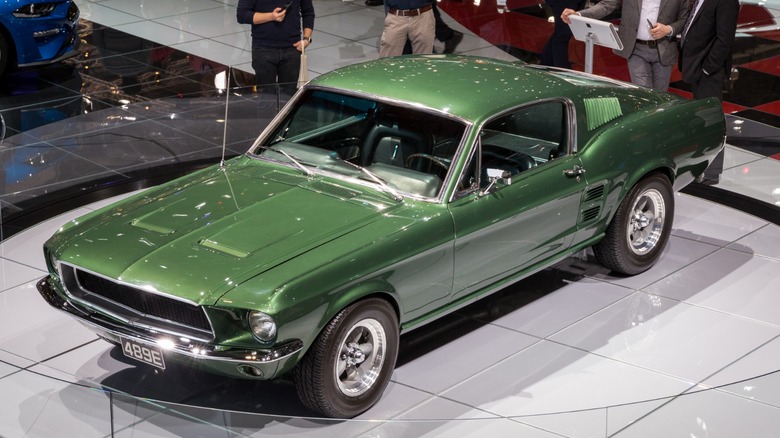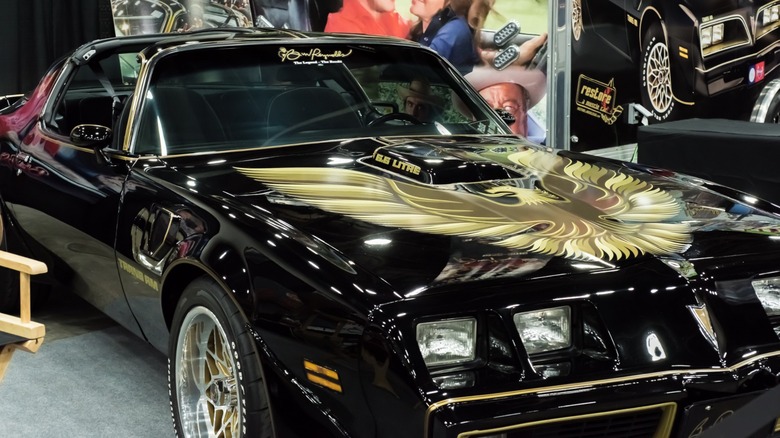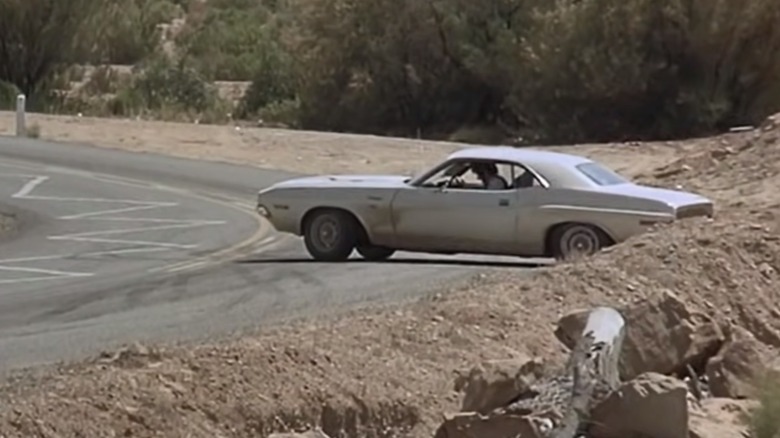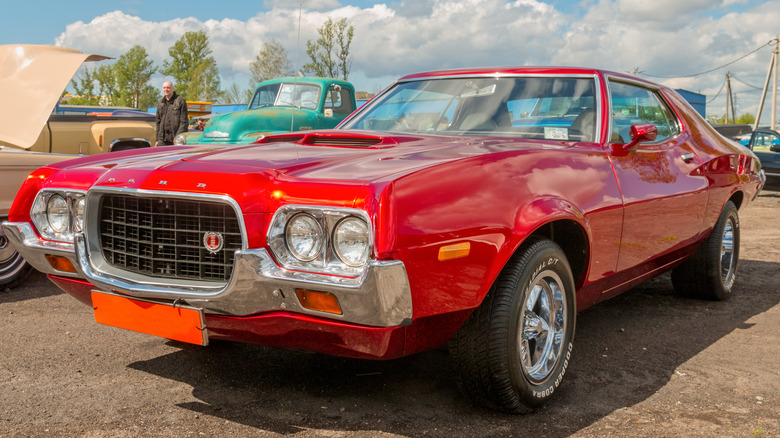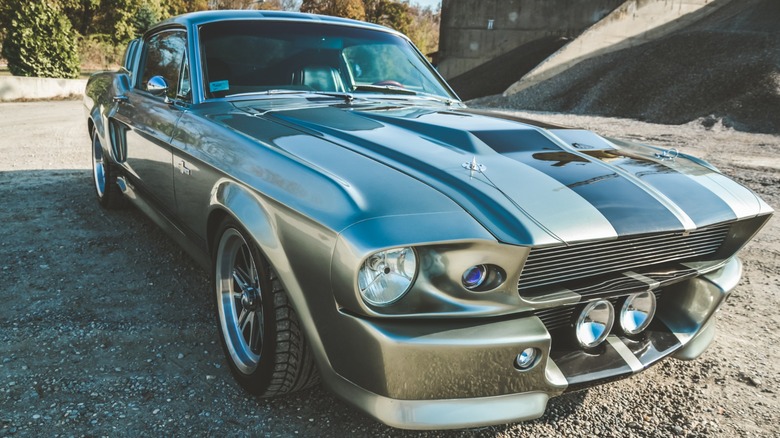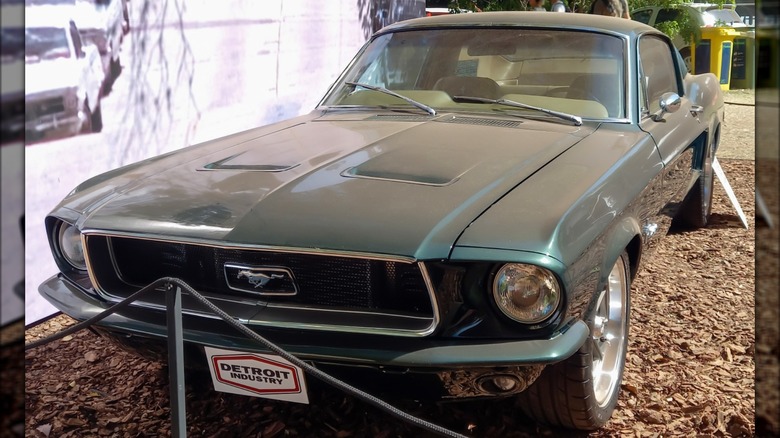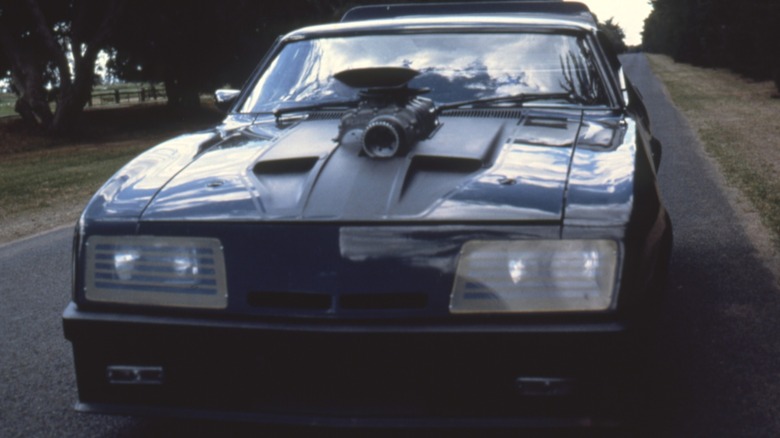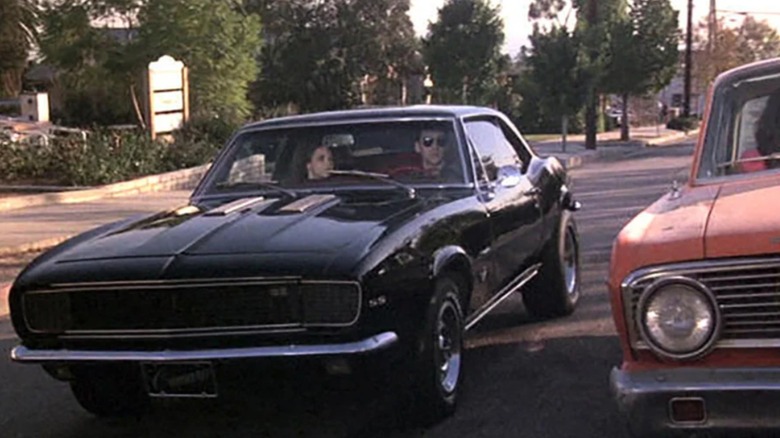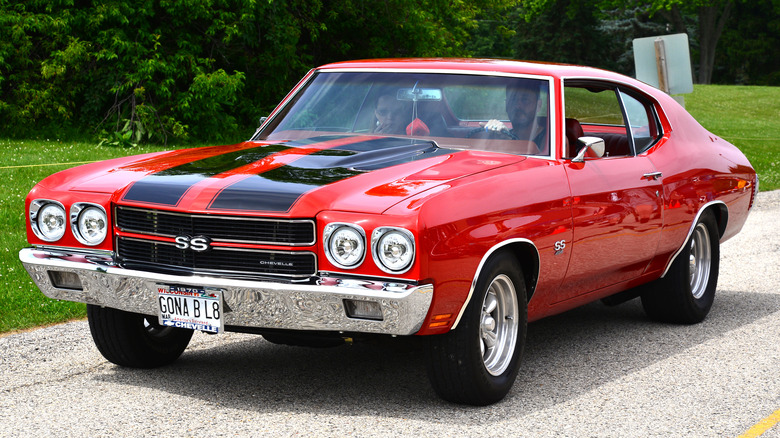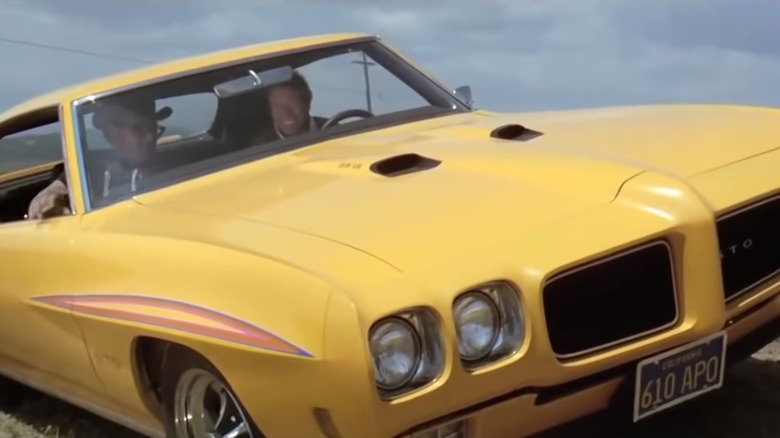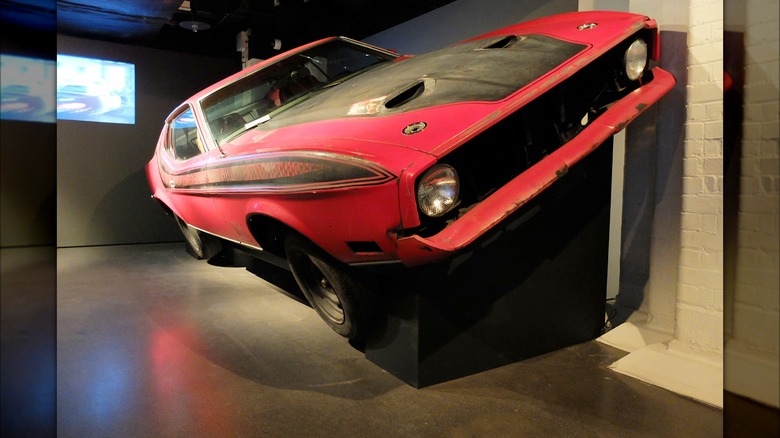10 Classic Muscle Cars That Made It To The Movies
A couple of enduring cultural icons born and raised in the United States are the Hollywood movie and the Muscle Car. While these things exist in other countries and on other continents, few have the enduring appeal of those originating from California and Michigan. Fortunately, as the so-called land of opportunity, we have a seemingly endless array of muscle cars and movies to enjoy, with a wide range of both spanning the decades. However, while the most iconic muscle cars that tend to be the most sought-after models hail from the late '60s, movies starring these cars span the ages.
While movies and muscle cars each stand as potential subjects of study and critique, the combination of the two can lead to heated debate over whose is the favorite and which is best. With such names as McQueen, McConaughey, and Reynolds coming up alongside Mustang, Chevelle, and Camaro, the one certain thing is everyone will have their favorite. Furthermore, a good muscle car is always a good way to keep more eyes on screens, and they often serve as an uncredited character. You may have a preference for Ford or Chevy just as you may prefer Spielberg over Scorcese.
Regardless, here are 10 classic muscle cars that made it to the movies.
1977 Pontiac Trans Am - Smokey and the Bandit
Hollywood had a banner year in 1977. A couple of the biggest titles of all time were released in that year. While most people know the biggest film was "Star Wars," other blockbuster films include "Close Encounters of the Third Kind," "Saturday Night Fever," "The Spy Who Loved Me," and "Smokey and the Bandit," in which, a shiny new 1977 Pontiac Trans Am is as much a star as Burt Reynolds or Sally Field.
During the 90 minutes that fill this comedy action film, we see Burt Reynolds in his prime as the bandit helping to ensure the prompt delivery of a truckload of bootleg Coors beer. In the hijinx that ensues, the Bandit (Reynolds) outsmarts an overly southern Texas sheriff, played by the inimitable Jackie Gleason, to throw him off the trail of the contraband alcohol. The truck driver known as "The Snowman," played by country music legend Jerry Red, handles the cargo pulling. Red even performs the movie's main theme. However, the true star of the show is the slick black Trans Am. Perhaps as many eyes were on the car throughout the film as were on the runaway bride (Fields) picked up by the Bandit along the way.
Despite stiff competition, this movie turned out to be a smash hit. Furthermore, sales of Pontiac Firebirds shot through the roof in the year after its release. Both the movie and the car continue to be fan favorites today.
1970 Dodge Challenger R/T 440 Magnum - Vanishing Point
The 1971 film "Vanishing Point" is one of those films when brought up in conversation receives a reaction from either those who have seen it and know it or those who have never heard of it. The seen-it and know-it camp are more than likely to be car enthusiasts who appreciate it for what they see it as, an hour-and-a-half car chase featuring a slick white Dodge Challenger R/T. While it may be of more substance and nuance than that, the car does loom large.
The Challenger in this film is driven by Vietnam vet and ex-cop Kowalski, who heads out on a tear across the desert fueled by drugs in his car. The car is meant to be delivered from Denver to San Francisco in just 18 hours, providing ample motive for driving well past the breaking point of most drivers and the repeated entanglements with highway patrol. Of course, the 440 V8 Challenger he is delivering is not a vehicle to trifle with on the highway, leaving men in uniform frustrated and eating his dust throughout the American West.
While the chase scenes tend to steal the show, its story-telling adeptly conveys the despair felt by many at the time along with the counterculture and anti-establishment fervor of the youth. Without mentioning any spoilers, let's just say the vanishing point found at the end of "Vanishing Point" is as bleak as its outlook.
1972 Gran Torino - Gran Torino
A car model rarely ends up in the title of a movie, much less becomes the title. Yet, the 2008 Clint Eastwood film "Gran Torino" did just that.
Clint Eastwood begins this film as a grizzled and hard-headed Korean war vet and retired Ford auto worker in Michigan who has just lost his long-time spouse and finds himself surrounded by family who doesn't call and ethnic neighbors who don't care. What he does not find among either group is connection, a place of belonging, and, least of all, understanding. Early on we discover he has a mint condition 1972 Gran Torino under cover in his garage. The car plays a small role in this film through most of the movie, only becoming central to the plot near the end. And while Eastwood's character begins the film without any connection to what he has long called home, he discovers one and finds a new purpose.
Though late in his career, this Eastwood-directed picture also starring him shows that he was still on top of his game. Though the vehicle played a smaller role than the film's title may indicate, the Gran Torino was in top condition and would make any retired Ford autoworker proud, just as it did for Walt (Eastwood) in the movie.
1967, 1971 Ford Mustang - Gone in 60 Seconds
"Gone in 60 Seconds" gives us a double-shot of muscle in what could be a drive-in double feature of muscle cars and action movies. The original film came out in 1974 starring nobodies, and the wildly popular remake starring Nicholas Cage and Angelina Jolie originally premiered in 2000.
"Gone" is light on depth and heavy on action. Both films follow a group of car thieves who have honed their thieving skills to the point of yanking cars in less than a minute. However, in both films, the prized car is a Ford Mustang called Eleanor. The 1974 film focuses on a 1971 Ford Mustang Mach I while the modern version uses a 1967 Shelby GT500, which is the real story of all. The 1971 model is a stock Mach I featuring a four-barrel 351 Windsor V8, which was the hot car at the time and one of the best performers of the era. However, by 2000, the Shelby GT500 had long been a classic car with an already climbing collector value and is heavily modified in the movie.
Since the release of this movie, Eleanor cars have been a regular fixture of pop culture, including being involved in a bit of controversy. Some intrepid car builders and YouTubers have built Mustangs as homages to the movie car, only to be slapped with lawsuits by the Shelby Trust claiming copyright violations. This courtroom drama may even be more interesting than the films, and you can read more about it on Autoblog.
1968 Mustang - Bullitt
Since the 1950s and the rise of hot rod culture, many of Hollywood's leading men have merged the worlds of movies and cars. Notably, James Dean and Paul Newman fit this mold, but none so well as Steve McQueen in the starring role of the 1968 film "Bullitt."
"Bullitt" may be the perfect movie. It is an action, cop, and mafia movie rolled into one, filled with action, shootouts, and car chases. It is not the kind of film to win the highest of accolades from film critics but sells tickets nonetheless. Lt. Frank Bullitt (McQueen) is tasked with protecting and delivering a witness against the mob to a Congressional hearing. Bullitt is the quintessential maverick detective who forges a unique path in upholding the law in this police procedural, and McQueen's acting chops are as polished as ever in this role. The film itself has received high praise over the years, mostly from fans, but the car driven by Bullitt has since become legendary.
Bullitt drives a 1968 Ford Mustang GT 390 Fastback in the movie. It is best remembered in this film for a nearly 10-minute scene chasing a 1968 Dodge Charger R/T that sees Bullitt switch between chasing and being chased in classic cat-and-mouse action. Bullitt's car is painted Highland Green and is devoid of any badging, adding to its mystique. The screen-used car has become a collectible car sold at auction recently while Ford has released Bullitt Mustangs in 2001, 2008, and 2019, securing the legacy of McQueen as Lt. Bullitt.
1973 Ford Falcon - Mad Max
Anyone who thinks the muscle car is exclusive to American culture needs to spend some time Down Under. Though Australia has long had a presence from GM and Ford, its cars have often been unique to the continent. However, while Australian cars have been largely kept for domestic use, its movie stars have gone on to roles in the biggest blockbusters worldwide. American actor Mel Gibson received his first big break in Australia when he was chosen for the lead role of the first "Mad Max" movie, police office Max Rockatansky. Furthermore, this movie featured American and Australian actors as much as it did Australian automobiles.
While this post-apocalyptic thriller features loads of classic Australian iron from Holden Monaros to various Ford Falcons along with a couple of Kawasaki motorcycles and assorted trucks and vans, it is the titular character's Pursuit Special that steals the show. In Max's quest to fulfill his duties to the court, he drives what is based on a 1973 Ford XB Falcon GT 351, a popular and sought-after muscle car in the area. The Pursuit Special is outfitted with a full-fledged blower rising high above the hood and included in the soundtrack are the tell-tale whines of a large supercharger.
While fans of the movie have made recreations of the car over the years, the screen-used car survived the years intact. As recently as 2020, it went up for sale by the Orlando Auto Museum.
1967 Chevrolet Camaro SS - Better Off Dead
One of the most endearing coming-of-age 1980s screwball comedies, "Better Off Dead," holds a special place for a generation of adults who grew up in the age of recurring cable movie re-runs before streaming ever became a thing. In one of John Cusack's early leading roles, he plays Lane Meyer, a high schooler approaching adulthood with dread. Disappointments from his family, girlfriend, friends, and local society leave him with a bleak outlook and an even bleaker social life. However, his fortunes turn around after meeting the attractive French exchange student staying with his oddball neighbors and with the resurrection of his eternally broken car, a black 1967 Chevrolet Camaro SS.
"Better Off Dead" is a lighthearted film full of memorable and meme-worthy lines and a story of redemption and reward with which many of us can relate. Taunting and challenges to race both on the streets and on the ski slopes give out protagonist a reason to challenge himself to prevail. However, after repeated failures in getting his car going, Lane discovers the French neighbor has figured out its problem and repaired it, giving him a chance on the street against his rivals and an unexpected chance with her at romance.
The movie car is a Super Sport model, although its stock 350 V8 was swapped for a 400. Producers also opted for 125-inch wheels and added a rear spoiler. The car plays a relatively small but important part in the movie, and a fan later found the exact car and has since restored it to its on-screen condition.
1970 Chevy Chevelle SS - Dazed and Confused
While the 1970s and 1980s brought us "American Grafitti" and "Fast Times at Ridgemont High," the 1990s gave us "Dazed and Confused." All of these coming-of-age films have since become beloved classics and all of them feature automobiles as central to the plots. "Dazed" centers on the last day of school and culminates in a huge impromptu party at the town's water tower.
Set in 1976, this film features many of the cars you might have seen in a small town and at a high school of that time. As most of the characters are students, they are not in brand-new cars, meaning most models are from the late '60s and early '70s. Some of the highlights of the film, in automotive terms, are a Pontiac GTO, Plymouth Duster, Pontiac Trans Am, and a 1970 Chevelle SS driven by Wooderson, played by Matthew McConaughey, who keeps coming around to hang out with the high school kids. In this iconic role, Wooderson is known for being the kind of "bad influence" most decent kids avoid and McConaughey has since become known for the improvised iconic line, "Alright, alright, alright." It also happens to be the first words he ever uttered on film.
As Wooderson describes his Chevelle in the movie, "We got 4:11 Positrac outback, 750 double pumper, Edelbrock intake, bored over 30, 11 to 1 pop-up pistons, turbo-jet 390 horsepower." Indeed, it is a cool car with impressive specs, whether the year is 1976 or 2023.
1970 Pontiac GTO Judge - Two-Lane Blacktop
In the cult classic, "Two-Lane Blacktop," Beach Boy Dennis Wilson and fellow musician James Taylor find themselves playing the characters of "The Mechanic" and "The Driver," respectively, crossing the country in a highly modified 1955 Chevy gasser, racing for money to fund their listless journey. For both musicians, this film would be their only dramatic role while their characters would challenge GTO, played by veteran actor Warren Oates, to a race for pink slips. He drove an Orbit Orange Pontiac GTO, a formidable opponent on the streets.
"Two-Lane Blacktop" was a very low-budget movie using unproven actors, except for Oates, and a script that seems light on substance. The plot itself is a bit meandering and pointless but is full of action on the streets and highways. The star vehicle is the 1955 Chevy, though it is less of a muscle car than it is a hot rod. The Chevy used either a 455 or 4278 crate engine delivered by General Motors for use in the film, while the GTO was most likely equipped with the optional 455 V8 available in 1970 from the factory.
Though the GTO features some of the trim options used on The Judge models for 1970, it is missing the emblems of that iconic special edition car. People involved in production claim to have used the car just as delivered by Pontiac, so the exact nature of the car has been left up for discussion in the decades since. "Two-Lane Blacktop" was a very cheap film that flopped at the cinema, meaning the GTO is long gone and only its legacy on film survives.
1971 Ford Mustang Mach 1 - Diamonds Are Forever
While James Bond is known for driving one of several high-powered and specially equipped British performance cars, the 007 franchise occasionally has to make do with whatever is found locally. For example, our esteemed international spy finds himself driving a Ford Fairlane while in Cuba in 2002's "Die Another Day," while in 1982's "Octopussy," he escapes murderous thugs in a Bajaj RE tuk-tuk while in India. Likewise, a similar scenario plays out during a trip to Las Vegas in "Diamond Are Forever."
In this installment of the franchise, Bond finds himself fleeing from local police in a 1971 Ford Mustang Mach I. In a sort of modern Keystone Cops routine, Bond leads them on a chase through the Vegas strip and back, eventually getting away by performing a stunt with the Mustang driving on two wheels and escaping through a narrow alleyway. While the Mustang shows up in multiple scenes throughout the film, this is the most memorable.
Bond drives the Mustang in this film ostensibly because he is in Las Vegas and American cars are more readily available. In reality, EON Productions had made a product placement deal with Ford and it was stipulated that the character would drive a Ford product. Since the Mach I was its top performance model at the time, it became Bond's car. While the film gave Ford a big publicity push, it would not be until "The Spy Who Loved Me" in 1976 that he would go back to a proper English car, a Lotus Esprit.
